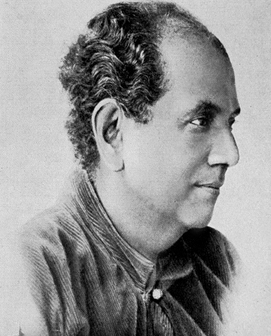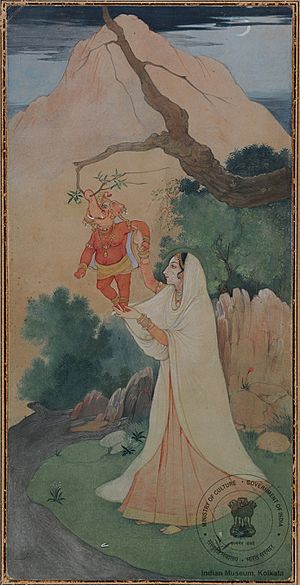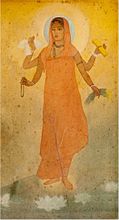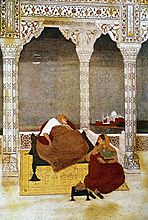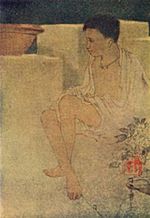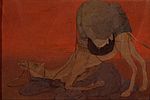Abanindranath Tagore facts for kids
Abanindranath Tagore (অবনীন্দ্রনাথ ঠাকুর) was a very important Indian artist and writer. He lived from August 7, 1871, to December 5, 1951. He is known for starting the "Indian Society of Oriental Art." He also helped create the famous Bengal school of art. This art movement changed how modern Indian painting developed.
Tagore was also a great writer, especially for children. People often called him 'Aban Thakur'. His books like Rajkahini, Budo Angla, Nalak, and Khirer Putul are famous in Bengali language children's literature.
He wanted to update old Indian art styles, like those from the Mughal and Rajput periods. He did this to offer an alternative to the Western art styles taught in schools during the British Raj. Abanindranath and other artists from the Bengal School wanted to create a national Indian art style. They found ideas from places like the Ajanta Caves. His art became very popular and was even seen as a national Indian style by British art groups.
Contents
Who was Abanindranath Tagore?
Abanindranath Tagore was born in Jorasanko, Calcutta, which was part of British India at the time. His parents were Gunendranath Tagore and Saudamini Tagore. He came from the famous Tagore family. His uncle was the well-known poet Rabindranath Tagore. His grandfather and older brother, Gaganendranath Tagore, were also artists.
Abanindranath started learning art in the 1880s at Sanskrit College, Kolkata. In 1890, when he was about 20, he went to the Calcutta School of Art. There, he learned to use pastels and oil paints from European teachers.
In 1889, he married Suhasini Devi. He also studied English at St. Xavier's College for a while. He had a sister named Sunayani Devi.
How did his painting career begin?
In the early 1890s, some of his drawings were printed in magazines like Sadhana. He also drew pictures for his uncle Rabindranath Tagore's books and his own books. Around 1897, he took lessons from the vice-principal of the Government School of Art. He learned many European art techniques, but he especially liked watercolors.
At this time, he became interested in Mughal art. He painted many works about the life of Krishna using a Mughal-inspired style. He worked with E. B. Havell to improve art teaching at the Calcutta School of Art. His brother Gaganendranath also helped by setting up the Indian Society of Oriental Art.
Tagore believed in traditional Indian painting methods. He felt that Western art focused too much on things you could touch. He wanted Indian art to return to its spiritual roots. He was inspired by Mughal painting and also by Whistler's ideas about art. Later, he started adding ideas from Chinese and Japanese art to his own style.
What was his later work like?
Tagore thought that Western art was too "materialistic." He believed India needed to go back to its own traditions to find spiritual meaning in art. Many British art experts at the time agreed with these ideas. This was partly because Hindu philosophy was becoming popular in the West.
One of his best works was the Arabian Nights series, painted in 1930. In these paintings, he used stories from the Arabian Nights to show what colonial Calcutta was like. He also showed how different cultures were mixing there.
Because his ideas were so successful, Tagore met other important people from Asia. These included Japanese art historian Okakura Kakuzō and painter Yokoyama Taikan. In his later art, he started to mix elements of Chinese and Japanese art. He wanted to create a new Asian art style that combined the shared spiritual and artistic ideas of the East.
Many famous artists were his students. Some of them were Nandalal Bose, Asit Kumar Haldar, Sarada Ukil, and Mukul Dey.
Abanindranath had a long friendship with William Rothenstein, an artist from London. Rothenstein visited India in 1910 and spent almost a year exploring cultural sites. He visited the Ajanta Caves and Benares. He ended up in Calcutta, where he painted with Abanindranath and his students.
This friendship led to an important cultural event. Rabindranath Tagore stayed at Rothenstein's home in London. This led to the English version of Rabindranath's book Gitanjali being published. In 1913, Rabindranath won the Nobel Prize for Literature. The success of Gitanjali helped make Abanindranath's art projects more known in the West too.
Abanindranath became the head of Visva Bharati University in 1942.
Where can we see his art today?
After Abanindranath Tagore passed away in 1951, his oldest son, Alokendranath, gave almost all of his father's paintings to the Rabindra Bharati Society Trust. This trust is located at their family home in Kolkata. Since very few of his paintings were collected by others during his lifetime, the Rabindra Bharati Society became the main place where his works are kept.
For a long time, these paintings were stored away. Because of this, the full range of Abanindranath's amazing art was not widely known to the public. Only a small group of art experts in Bengal knew about them. Some experts, like K. G. Subramanyan and R. Siva Kumar, have said that his best work was done in the 1920s, 30s, and 40s. R. Siva Kumar's book Paintings of Abanindranath Tagore (2008) is an important book that helps us understand Abanindranath's art better.
List of his paintings
Here are some of the paintings by Abanindranath Tagore:
|
|
Images for kids


